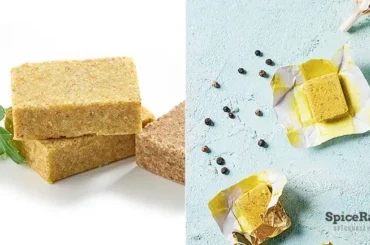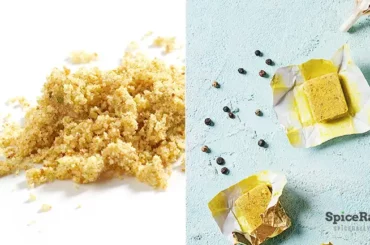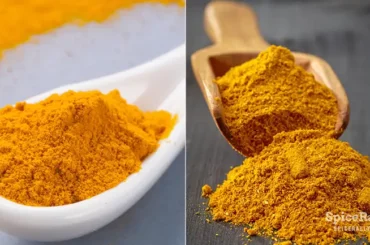We actually don’t always get confused with some seasoning blends, yet, it is worth knowing their ins and outs when cooking- so here’s everything about tajin seasoning vs cajun seasoning.
Tajin seasoning is mainly used as a condiment, while cajun seasoning often works as a cooking ingredient. And cajun seasoning comes together with many herbs and spices, but tajin seasoning contains only three main elements. So, their flavors and usage in cooking differ significantly.
On that note, check out the table and description below to learn further about these two blends
Tajin Seasoning vs Cajun Seasoning
| Tajin Seasoning | Cajun Seasoning | |
|---|---|---|
| Main ingredients | – Mild red chili peppers – Dehydrated lime juice powder – Sea salt Homemade or copycat versions might also include: – Citric acid – Sugar – Dried lime zest – Paprika – Cayenne pepper powder – Chili powder – Garlic powder – Ground coriander – Onion powder – Ground cumin | – Red pepper – Paprika – Black pepper – White pepper – Cayenne pepper – Garlic powder – Onion powder – Thyme – Oregano – Salt Some recipes also contain: – Celery seed – Red pepper flakes – Sugar |
| Base Flavor | Savory and sour | Hot and spicy |
| Flavor Profile | It is less intense and pungent than cajun seasoning with salty, mildly spicy, and tart flavor notes. It can be sweet if sugar is added. | Sharp, intense, and spicy than tajin seasoning with earthy, warm, smokey, and umami undertones. |
| Heat Level | Barely hot and often less hotter than cajun seasoning. | Hotter than tajin seasoning |
| Texture | A powdery, dry mixture | A powdery, dry mixture |
| Color | It has a red tone | Is typically reddish-brown in color |
| Mode of usage | It is particularly used as a condiment, while it is also used for seasoning purposes. | Mainly used as a cooking ingredient. |
| Usages in cooking | – To flavor snacks and dipping sauces like roasted nuts, trail mixtures, potato chips, sweet potato fries, guacamole, etc. – Add a spicy kick to alcoholic beverages like tequila cocktails, beer cocktails, margaritas, Bloody Mary, etc. – To be incorporated into wet rubs and marinades made for chicken, turkey, steak, pork, and vegetables. – It can also be integrated with sweet treats like sorbet and popsicles for a punch of flavor. – To be mixed into fresh, grilled, or dehydrated fruits like pineapple, watermelon, oranges, apples, peaches, etc. | – Primarily used to season meat, fish, and other seafood. – It is great when mixed into savory rice dishes like Jambalaya. – Can be sprinkled on pita chips, crackers, fries, or roasted nuts. – It adds an excellent taste to all kinds of roasted potatoes and other vegetables like eggplant, onions, zucchini, etc. – It can be incorporated into dips, sauces, soups, and stews. |
| Origin | Mexican cuisine | Southern American cuisine |
| Mode of production | Mainly produced under one brand, but copycat/homemade recipes exist. | Both commercially made and homemade recipes exist. |
| Availability | – Comes under one brand in different packagings and quantities. – Can be easily purchased from leading supermarkets, grocery stores, and online shopping sites. | – Comes under many brand names in different packagings and sizes. – Readily available in grocery stores, online sellers, and leading supermarkets. |
| Storage | – Once opened, it should be stored in a tightly-sealed glass bottle/jar/container to have a longer shelf life. – Can be kept with other dry herbs, spices, and blends in your pantry/ spice cabinet in a dark, cool, dry place. | – Once opened, it should be stored in a tightly-sealed glass bottle/jar/container to have a longer shelf life. – Can be kept with other dry herbs, spices, and blends in your pantry/ spice cabinet in a dark, cool, dry place. |
Elaborating The Difference Between Tajin Seasoning And Cajun Seasoning…
As we have explained in the table above, these two seasoning blends are way different from each other. Although they look similar in appearance and sound a bit similar, their flavors and usage in cooking are not the same at all.
Moreover, tajin seasoning is actually popular among the community as a brand, while cajun seasoning is basically a cultural seasoning blend from the southern USA.
You can buy cajun seasoning under many brand names, and homemade recipes often vary slightly in ingredients. Meanwhile, tajin seasoning comes to the market under one brand name and revolves around the same set of flavoring elements.
Moreover, tajin seasoning and cajun seasoning cannot be used interchangeably due to their significant difference in flavor profiles. Cajun seasoning often accompanies savory dishes, while tajin seasoning is versatile enough to be used in both sweet and savory dishes.



